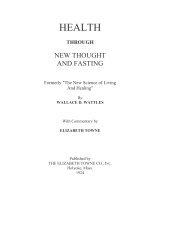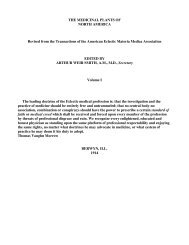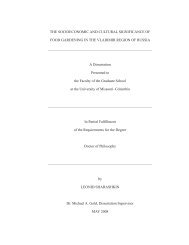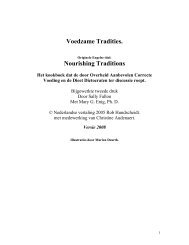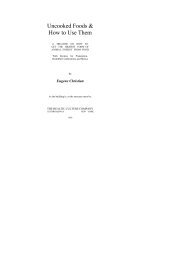FACTORS OF SOIL FORMATION - Midlands State University
FACTORS OF SOIL FORMATION - Midlands State University
FACTORS OF SOIL FORMATION - Midlands State University
You also want an ePaper? Increase the reach of your titles
YUMPU automatically turns print PDFs into web optimized ePapers that Google loves.
FIG. 12.—Triangular presentation of the composition of the Cecil fine sandy loam<br />
profile given in Table 2. Note the accumulation of clay in the B horizon.<br />
For the purpose of interpretation of chemical data, it is advisable<br />
to construct a table of molecular values by dividing the customary<br />
percentage data by the molecular weights. If a soil contains 55.90 per<br />
cent SiO 2 , the molecular value is 55.90/60 = 0.932. Chemists are<br />
determining atomic weights more and more accurately, and this<br />
necessitates endless recalculations of molecular values. Since these<br />
changes are beyond the accuracy of soil and rock analyses, it appears<br />
expedient to use the rounded figures of H. S. Washington that Niggli<br />
(7) advocates for international use.<br />
SiO 2 = 60 TiO 2 =80 S = 32<br />
Al 2 O 3 = 102 P 2 O 5 = 142 Cr 2 O 3 = 152<br />
Fe 2 O 3 = 160 MnO = 71 NiO = 75<br />
FeO = 72 ZrO 2 = 123 CoO = 75<br />
MgO = 40 CO 2 = 44 BaO = 153.5<br />
CaO = 56 SO 3 = 80 SrO = 103.5<br />
Na 2 O = 62 Cl 2 = 71 Li 2 O = 30<br />
K 2 O =94 F 2 = 38<br />
Molecular values offer many advantages. In the first place, we are<br />
not so much interested in the weight changes of the soil constituents<br />
as in changes in their atomic and molecular proportions.<br />
Stoichiometric relationships are more clearly brought out by<br />
molecular data than by weight figures. In the second place, chemistry<br />
has shown that chemical laws assume the simplest form when<br />
expressed in molecular relationships.<br />
In order to reduce the number of items in a table of analyses, two<br />
or more values may be combined into ratios. The following quotients<br />
and symbols are often encountered in soil literature:




